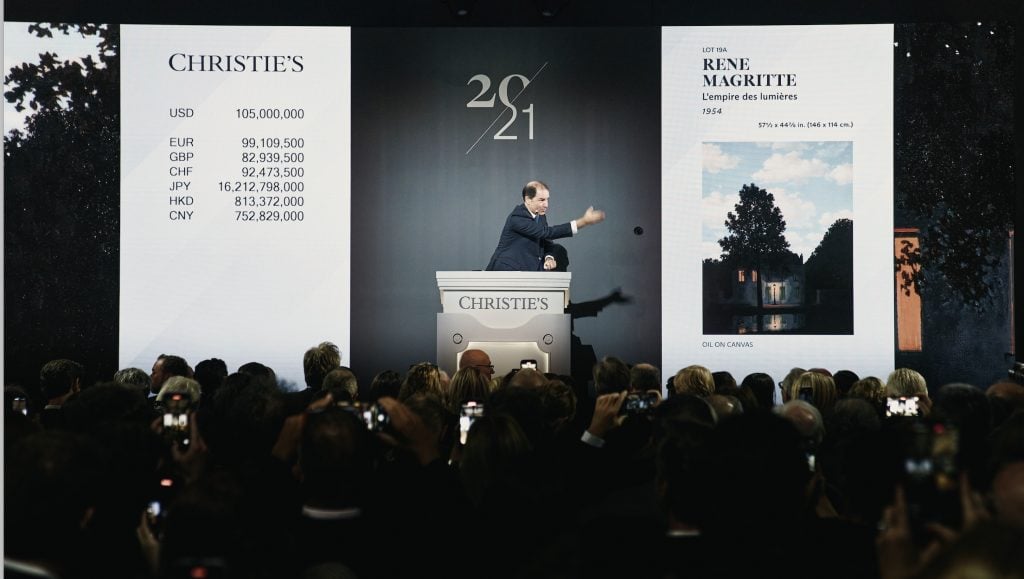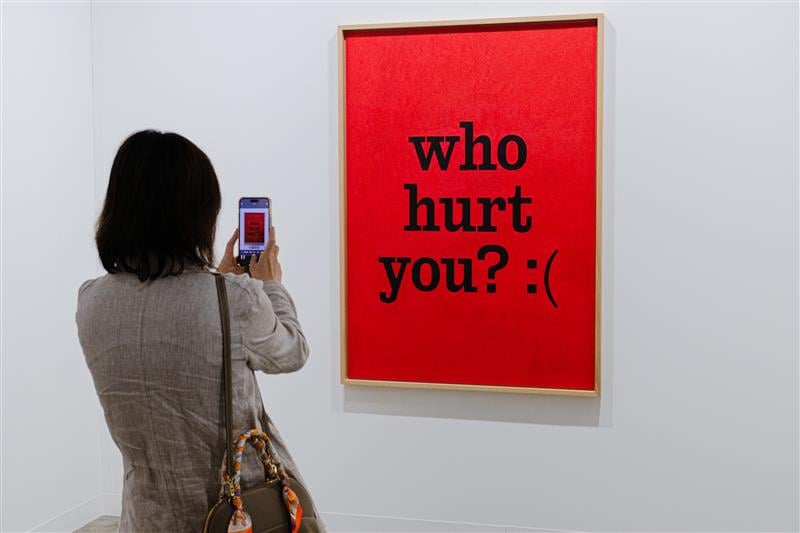A version of this article originally appeared in The Back Room, our lively recap funneling only the week’s must-know art industry intel into a nimble read you’ll actually enjoy. Artnet News Pro members get exclusive access—subscribe now to receive the newsletter in your inbox every Friday.
Anyone watching global markets this week might be suffering from whiplash as U.S. President Donald Trump paused his reciprocal tariffs for the next 90 days (except when it comes to China). The 180 from last week’s chaos has many in the art trade breathing a sigh of relief for the temporary reprieve, even if the stock market has yet to fully rebound. But big questions remain, not just about tariffs, but how the art market is adapting to major economic, geopolitical, and generational shifts.
That was the subject of Monday’s virtual discussion between Artnet’s editor-in-chief Naomi Rea and senior reporter Katya Kazakina, who penned the lead report of our latest Intelligence Report: The Year Ahead 2025, which chronicles how tastes and trends are changing. The webinar offered Artnet readers a chance to raise their most pressing concerns and queries about the market. Below, we’ve distilled these down into four key questions.
Q: How are macroeconomic forces—from higher interest rates to fears of a recession amid tariff changes—reshaping the art market in real time?
A: According to Artnet’s data, last year there was a steep decline—44.2 percent year over year—in sales of trophy works at auction, or those sold for over $10 million. This suggests that economic uncertainty has billionaires reticent to buy and collectors less willing to sell. Kazakina pointed out that, up until the last few years, the market had relied on these high value lots, and their absence “really skews” the auction market downward, although “just a couple of works really can shift this equation.”

Adrien Meyer, Christie’s global head of private sales and co-head of Impressionist and Modern art, sells the top lot of Christie’s Modern evening sale in November, René Magritte’s L’Empire des Lumières, for $121.2 million. Courtesy of Christie’s.
Still, sales in the $100,000-to-$1 million range remained resilient amid last year’s downturn, suggesting that profit-driven speculators are sitting back, and a broader collector base is interested in buying more affordable works they are passionate about. “That’s exactly the price bracket where younger collectors can participate much more actively,” Kazakina noted.
As for tariffs and recession fears: it’s difficult to read the tea leaves amid an on-again, off-again global trade war, but rising costs and increased trade friction are contributing to a broader deceleration of globalization in the art trade. Art may begin moving shorter distances, and buyers thinking more locally.
Q: Are we witnessing a generational shift in collecting power, and what new trends or priorities are emerging because of it?
A: Millennials and Gen Z accounted for a quarter to a third of bidders at the two major auction houses last year, more than doubling their share in five years. They’re not chasing the same names their parents’ generation did. As one advisor told Kazakina: “What 45-year-old today is sitting on the edge of his or her chair, desperate for the moment they’ll be able to buy Jasper Johns?”

A guest takes a photo at an artwork by Nora Turato during Art Basel Hong Kong 2025 preview night at the Hong Kong Convention and Exhibition Center on March 27, 2025, in Hong Kong, China. Photo: Keith Tsuji/Getty Images.
With an estimated $84 trillion set to change hands in the next 20 years, the so-called “great wealth transfer” is certainly underway. But a lot of younger collectors are less interested in cultivating a specific kind of collection and are buying across categories. They are also more willing to buy art online: more than 29,000 works sold online in 2024, a 6.6 percent uptick from the previous year.
Q: What kinds of art are gaining or losing relevance in this shifting market?
A: The “blue-chip” is being redefined. While stalwarts Warhol and Picasso remain in the top in terms of search and sales, others have seen values decline as tastes move away from the postwar canon. Kazakina pointed to artists such as Christopher Wool and Rudolf Stingel as examples. On the rise: historically overlooked artists, especially women and artists of color; ultra-contemporary names priced for access; and digital-native creators, albeit with less froth than in the NFT boom of 2021.

A Christopher Wool artwork is displayed at Christie’s “Impressionist, Contemporary and Modern” art preview at their King Street Branch Photo: Rune Hellestad/Corbis via Getty Images.
Meanwhile, Artnet’s Wet Paint columnist Annie Armstrong has charted the ascent of “red-chip” art, or that which she said is defined by its refusal to revere art history, perhaps as a part of a broader rejection of elite, specialized knowledge. Artists like Tom Sachs, Alex Israel, Damien Hirst, Harmony Korine, Yoshitomo Nara, and Banksy fall into this category that is popular with a subset of collectors under 45.
Q: Which regions are driving growth, and where is the next frontier of the global art market?
A: The U.S. remains the largest market despite a 25.5 percent contraction between 2023 and 2024, but centers of gravity are shifting—fast. China’s auction sales fell more than 46 percent last year, while the U.K.’s auction sales totals continue to shrink, reaching the lowest level in a decade in 2024. Additionally, business in the Middle East has skyrocketed, with Sotheby’s hosting its first international art auction in February and the recent expansion of Art Dubai with two senior hires from Art Basel. (The 19th edition of the fair opens next week). The smart money is watching private sales activity, local fairs, and online sales outside traditional art world capitals. Geopolitics, currency volatility, and shipping logistics are all influencing where art moves—and who’s buying.
This post was originally published on this site be sure to check out more of their content







